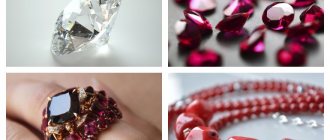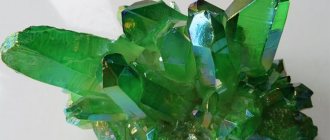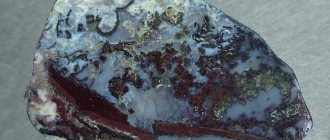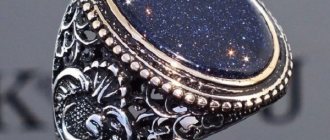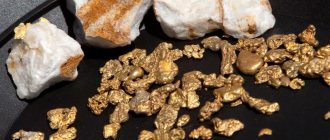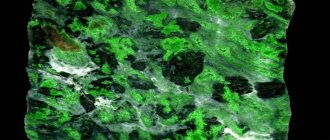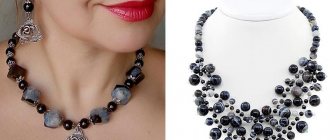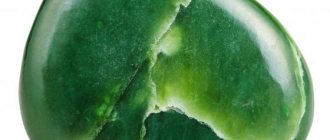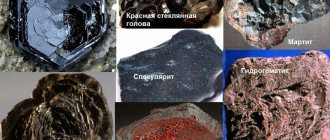Good afternoon dear friends! Our article today is dedicated to aventurine - the ruler of the souls of fashionistas and fashionistas of past centuries. They say that Queen Cleopatra and her lover Julius Caesar admired him. However, despite its advanced age by human standards, this stone still delights us with its beauty and grace. It is its enchanting unearthly beauty that makes dishonest people look for an opportunity to imitate it. We will talk further about how to distinguish aventurine from a fake.
History and origin
The jewelry name for this gem - aventurine - goes back to the Romance languages, in particular to French, Italian (Tuscan dialect) and their common predecessor - Latin. The Latin root advenio means "to happen" in the sense of "happening unexpectedly."
Ironically, aventurine was originally called a fake of this stone, obtained in a glass-blowing workshop on the island of Murano near Venice. In the 16th century, a glassblower accidentally dropped a handful of copper filings into the glass mass - the result was multi-colored glass, surprisingly similar to the famous ornamental stone.
Brick-colored aventurine
The original European name for aventurine has not been preserved; the gem was “renamed” in honor of a happy occasion. In Russia of the 17th–19th centuries, a stone speckled with a thousand sparkles was called “gold spark” or “spark” . There is also such a name as aventurine quartz.
This is interesting! In Russian, the jewelry name zlatoiskra is consonant with the word “adventure,” that is, “an ill-conceived risky operation, an adventure.” It must be admitted that from an esoteric point of view, aventurine corresponds to its name 100%.
History of the origin of the stone
The mineral has been known since ancient times; then it was considered one of the most expensive stones, which could only be owned by representatives of royal families and nobility. The birthplace of the mineral is Brazil, Chile and Australia, countries where the richest reserves of the shimmering mineral are located.
The name of the mineral comes from the name of the glass color of the same name, which, by a happy accident, was “invented” by an Italian glassblower. Thanks to chance, small copper shavings got into the mass, resulting in a bizarre shimmering glass with an unusual color. “Avventura” - from Italian “accident”, “coincidence of circumstances”. Due to its similarity with the technology for producing shimmering glass, the natural stone received the same name - aventurine.
The name suits it perfectly! In Europe, this stone was revered by people who loved to play with fate. Aventurine could attract good luck, reward with success, enrich, attract the other half, but he did it spontaneously - one could never know for sure how exactly the stone would manifest itself in reality.
Physicochemical characteristics
From a geological point of view, aventurine is a type of quartzite that has a complex heterogeneous structure. The basis of the stone is quartz, which over millions of years of geological processes has been compressed with particles of mica, hematite, goethite, iron hydroxides and some other substances. The heterogeneity of the structure, combined with chaotic inclusions of coloring substances - chromophores - gives aventurine its characteristic appearance.
| Formula | SiO2 |
| Color | White, pink, yellow, red, brown, green, blue. |
| Shine | Fatty |
| Transparency | Not transparent |
| Hardness | 6 — 7 |
| Cleavage | Absent |
| Kink | Conchoidal |
| Density | 2.6 g/cm³ |
Thanks to its quartz base, it has a high hardness of 6–7 on the Mohs scale. Harder than glass. It polishes well, and after cutting it acquires a slightly greasy shine. Some samples have a noticeable iridescence effect - bluish-yellow iridescent tints at a certain angle of incident light.
Bluish-yellow overflow during processing
Physical properties
In the structure, against the background of the main color, reflections of light go deeper, the mineral begins to sparkle, as if winking. This effect is due to the presence of hematite or muscovite particles and is called aventurescence.
Blue aventurine
Since ancient times in Russia, high-quality samples have been used in the manufacture of jewelry: earrings, brooches, rings. Less decorative stones were used to make: candlesticks, vases, inserts for forks and knives.
Jewelers appeal to the following characteristics:
- The chemical formula of the structure is SiO2.
- Density - 2.65.
- Material hardness - 7.
- The composition may include mica, goethite, iron hydroxides, hematite.
- Glass shine.
- There are no adhesions, transparent.
- Trigonal syngony.
- The fracture is conchoidal.
Often the shade of the stone is affected by cracks filled with iron hydroxides. The rock has a variable structure and can be lepidogranoblastic, granoblastic or heterogranoblastic. It may contain muscovite, apatite, leucoxene, rutile; their number ranges from 5–15%. The grains are isometric and clearly defined, up to 3 mm in size.
Mining locations
Aventurine is a fairly common gem found in nature. In Russia, its deposits are located in the Urals, in the town of Taganay (by the way, hence the local name - “taganaite”). Other mining areas are scattered around the world: in Europe they are located in Austria, Spain and Norway, in Asia - in China and India, in the Americas, production is carried out in Chile, Brazil and the USA. It is also found in Australia.
It should be noted that gold sparks of different colors are mined in different deposits . In Asia, green is most common, in the US - golden, and so on.
Colors and varieties
Aventurine has surprisingly many faces - exactly like His Majesty's case. Its main colors are green, honey, gold, cherry, but the color of the spark is not uniform: the main color is “accompanied” by tints, stripes, dots and inclusions of other colors - white, gray, golden, brown, purple. In fact, the stone is painted in very small speckles, and only its background color is clearly identified.
The least common varieties are pink, blue and black. The last two are most highly valued, as they are very beautiful. Alas, for the same reason, blue and black taganaites are the main objects of counterfeiting.
Blue aventurine
Black aventurine
The stone is not smooth to the touch, but fine-grained. The grain size varies among different subspecies, since it depends on the conditions in which the stone was formed. The main types of defects are large pores and shagreen.
The most common types:
- green with dark and light splashes, the so-called “Indian jade”;
- golden-cherry - burgundy stone with golden inclusions, very beautiful;
- plain cherry brown;
- yellow honey-colored, distinguished by a characteristic “spark”;
- uniform pinkish-white;
- white striped;
- cherry white striped.
Blue and blue-black gems are much less common. They can have golden, grayish, white and purple inclusions. Golden cherry has the smallest grain size and is the smoothest to the touch. This is exactly what the accidentally invented “Murano glass” with the addition of copper filings turned out to be similar to . Now it is known as aventurine.
Bracelet made of golden cherry aventurine
History of the stone
This is what the mineral looks like before processing.
The name of the stone has a very unusual history. The name as it is known today comes from the Italian term "avventura", which means "unusual coincidence". The appearance of this name is associated with a small legend.
Just as people had learned to make glass almost everywhere, a little-known Venetian artist accidentally dropped a few shavings of yellow copper into the molten glass. The resulting material was liked by witnesses of the incident due to its unusual structure. This is how the first aventurine was born, which, by coincidence, gave its name to the natural mineral.
Aventurine stone was called differently in different parts of the world:
- the Slavs called the stone “gold spark”;
- in India the mineral was known as "Indian jade";
- Americans nicknamed it “Colorado gold.”
In China, a royal seal was made from this type of quartz. The stone was considered exclusively imperial; even wealthy residents were not allowed to own it.
Today it is a popular decorative material for decorating boxes, elegant vases, exquisite candlesticks and netsuke figurines made from pure rock. You can find small accessories with a small element of rock - a keychain or pendant. Mineral collectors can also find unprocessed samples of aventurine of various colors and shades.
Medicinal properties
In lithotherapy (stone treatment), aventurine is considered one of the most “complex” stones. Data on the medicinal properties of aventurine vary greatly. This is probably due to the species diversity of minerals with this name and their different chemical composition. Aventurine may contain mica, hematite, copper, iron and other molecular formations - it is not surprising that the properties of the stone (of different subtypes) can vary greatly.
Most lithotherapists agree that aventurine is used to treat:
- dermatitis, including allergic;
- hair loss;
- nervous disorders (short term);
- migraine;
- hypo- and hypertension;
- colds;
- inflammatory diseases of the respiratory tract.
In addition, there is evidence of the ability of the golden spark to calm the soul, to rid its bearer of fears of a phobic nature (which have no basis in reality) . But you need to be careful when trying to use aventurine to treat mental problems - at the same time as it weakens a psychotic attack, it changes the person’s state of mind, giving him lightheadedness.
Zlatoiskr – red aventurine with golden sparkles
Aventurine is contraindicated for naturally careless and irresponsible people.
Magic properties
The first of the magical properties of this stone is its direct influence on a person’s character towards greater carelessness and frivolity. Aventurine, in full accordance with its name, gives its owner ease in the perception of life. This can be useful for people who are exhausted under the burden of personal debt, are hyper-responsible and suffer from workaholism. Therefore, natural aventurine is prohibited for people who are overly emotional and frivolous by nature .
The meaning of the aventurine stone is luck in its various manifestations. Pink, gold and cherry types of aventurine are valued by gamblers as talismans that bring good luck in gambling. To some extent, this effect is due to the stone’s ability to sharpen intuition and induce in the wearer a feeling of self-confidence (and even self-confidence), which is important when bluffing.
Pink aventurine is an excellent talisman for gamblers
Blue aventurine is the strongest amulet against immediate danger - a car accident, an accidental falling brick and other situations in which its owner may receive physical injury. It sharpens attention and speeds up reactions, improving the ability to quickly and correctly respond to emergency situations.
Ring with blue aventurine
Green taganaite is a stone of love. It can be recommended to married couples who are in a state of permanent discord. The stone mutually increases the empathy of people, making them more receptive and sensitive to the needs of their partners, which ultimately leads to the restoration of warm relationships in the family.
Green aventurine is a stone of family well-being
Rare black aventurine is a stone of sorcerers. The inherent magic of this stone facilitates entry into a trance state, which is used by practicing magicians for various needs, in particular, predictions and clairvoyance. Talismans and amulets with black aventurine enhance psychic abilities.
Magical black aventurine - the stone of magicians
Brown-colored gold sparkle with golden sparkles in some Eastern traditions is considered a stone associated with the worlds of higher beings - asuras and devas. With the help of this stone you can come into contact with entities from other energy layers, but how to do this is the secret of the Eastern mystical schools.
Brown aventurine beads
Please note: aventurine loves strong personalities who know their worth and know how to conduct their affairs without magical help. But even they are not recommended to wear jewelry with aventurine for too long, more than two to three weeks in a row. This is just as dangerous as an overdose of medicine: too active attraction of luck will sooner or later overflow the patience of higher powers, and serious problems will begin in the life of such a person.
Colors and types of stone
Types of stone depending on shade:
- Green - called fuchsite in honor of the mineralogist Fuchs. The greenish shiny tint occurs due to the chromium and mica flakes included in the composition. Activates brain activity, improves the financial condition of the owner, helps to get the desired position, open a profitable business or find additional income.
- Yellow porous aventurine owes its color to the muscovite contained in the composition. The stone will help strengthen the immune system, improve your emotional state and get rid of bad thoughts.
- Brown is a fine-grained mineral containing hematite. It attracts good luck, increases self-esteem, helps to quickly recover from stress and reveals creative potential.
- The pink gem contains iron and is considered the best talisman for strengthening family relationships and finding true love.
- Black aventurine has the highest density - it is recommended to use it as a talisman only for strong and emotionally stable individuals, whom it will protect from the evil eye or damage. A black stone can have a negative impact on the psyche of weak people and provoke the development of mental illness.
- The blue mineral improves relationships with colleagues and acquaintances, and also develops oratory skills, so it should be worn by public figures. Aventurine of this color is also recommended to be used as a talisman for people whose work involves danger to life: firefighters, rescuers, stuntmen or military personnel. It will protect them from various dangers and help them return home safe and sound.
- The red and white gem reveals the creative side of the owner and protects him from diseases.
- Striped Aventurine also helps enhance creativity. Jewelers most often use it to make souvenirs, which are recommended to be placed in the workplace.
Note! Blue and black aventurine are the rarest types of stone, so you can often find fakes on sale. Natural stone has a heterogeneous structure and has minor defects.
Zodiac compatibility
In astrology, aventurine is optimally suited to the signs of the Earth elements: Virgo, Taurus and Capricorn. This is due to the initial “down to earth” nature of the representatives of these signs, the lack of ability to take risks and win with charm and luck. On the contrary, golden sparks are strictly contraindicated for the signs of Fire - Leo, Sagittarius and Aries: there is already too much flame in their lives.
| Zodiac sign | Compatibility |
| Aries | — |
| Taurus | +++ |
| Twins | + |
| Cancer | + |
| a lion | — |
| Virgo | +++ |
| Scales | + |
| Scorpion | + |
| Sagittarius | — |
| Capricorn | + |
| Aquarius | + |
| Fish | + |
(“+++” – fits perfectly, “+” – can be worn, “-” – is strictly contraindicated)
Aventurine and zodiac signs
Compatibility of aventurine according to the horoscope with the signs of the zodiac.
Change
| Element | Zodiac sign | Characteristic |
| Fire | Aries, Leo, Sagittarius | It is not recommended to use aventurine as a talisman. It develops excessive emotionality in fiery natures, making them impulsive, which can lead to serious conflicts and health problems. The stone can attract negativity into the lives of these signs and enhance negative traits. |
| Earth | Taurus, Virgo, Capricorn | Helps overcome difficulties on the way to a set goal and achieve success in all endeavors, endows the owner with natural charm and enhances positive character traits. It is recommended to choose blue stones. |
| Air | Gemini, Libra, Aquarius | It is recommended to use amulets with aventurine in rare cases to attract good luck during an interview, the first meeting with new partners or an interesting person, as well as when passing an exam. For permanent wear, it is better for representatives of this sign to choose another stone. |
| Water | Cancer, Scorpio, Pisces | The stone will help improve relationships with your significant other, resolve long-standing conflicts, finish pending tasks and recover from illness in a short time. |
Compatibility with other gems
Aventurine quartz is a stone that combines two elements: Earth and Water. Therefore, it is a rather capricious gem that can behave quarrelsomely with many other minerals. It is strictly unacceptable to wear it with “fire” stones - diamond, ruby, heliodor, pyrope.
It is not recommended to wear it simultaneously with Air stones - tourmaline, topaz, amethyst, rock crystal, sardonyx, since Air and Water in combination create a storm. As a result of the mutual action of water and air stones, they will begin to work at odds, and wearing aventurine with any Fire stone will lead to the latter, being more aggressive, suppressing the effect of the golden spark.
Aventurine is best combined with the following minerals:
- heliotrope;
- agate;
- nephritis;
- cacholong;
- jasper;
- jade;
- turquoise;
- rauchtopaz;
- Labrador;
- emerald;
- opal.
All these are stones of Earth and Water.
Important: aventurine quartz is worn exclusively in silver. This stone, like silver, is dedicated to the Moon and therefore is not combined with gold - the Sun (however, it is rarely set in gold, primarily due to the discrepancy in cost).
Who can wear aventurine? Stone compatibility
Aventurine is an exotic stone with a changeable character. You need to “make friends” with him - he will see his “comrade” in the modern Ostap Bender, a gambling, easy-going person who doesn’t get attached to anything and doesn’t get discouraged by anything for a long time.
However, the mineral has amazing healing properties, and here it is ready to help every person who turns to it for help.
Zodiac sign compatibility
Aventurine is most suitable for Taurus and Cancer. It will add new colors, impressions and adventures to the lives of these signs. Aventurine, set in silver, is a talisman of violent and uncontrollable passions, feelings at the limit of emotions.
The mineral is also suitable for Pisces - it has an equally contradictory and complex character, and thanks to it, Pisces will be able to understand their own feelings, get rid of melancholy and worries, and gain a supply of vital energy.
Aventurine is favorable for such zodiac signs as: Virgo, Capricorn, Libra (especially for men).
Aventurine will have a contradictory influence on Sagittarius: it will bring them sudden luck, popularity, and in a short time it can deprive them of everything, bring financial ruin, and then again lift Sagittarius back to the heights of success.
The stone has unfavorable compatibility with fire signs: Leo, Aries.
Compatibility by name
Aventurine will give radiant beauty and happy love to a woman named: Vera, Evgenia, Larisa, Yuliana, Galina, Alexandra, Oksana.
Aventurine will bring success and luck both in everyday affairs and on the love front to a man with the name: Alexander, Maxim, Stepan, Ruslan.
Application
This is a popular ornamental stone that is used in souvenirs and jewelry . A silver ring with aventurine is suitable for both men and women (signet rings with blue or black taganaite are recommended for men). In addition, beads, earrings, pendants, and, less commonly, tiaras and other jewelry are produced with it. A simple pendant with this stone will also look good.
Pendant with green aventurine
Aventurine is often used for inlaying luxury items - boxes and chests; various figures and figurines are cut out of it. The standard cut shape is cabochon (flat base and hemispherical top), table cut is used for rings.
This stone is sometimes not cut at all, but only polished. It is quite popular in its “unprocessed”, raw form. For the needs of those involved in home crafts, aventurine is often produced in the form of spherical or toroidal beads, hearts, fangs, drops, pyramids and similar shapes.
How to spot a fake
Unfortunately, fake aventurines are far from uncommon on the market. Most often, “aventurine glass” containing additives is passed off as a real stone: shavings of non-ferrous metals, primarily copper.
It’s easy to distinguish imitation:
- Firstly, it is bright and contrasting. A very rich color, especially red-brown, black or blue with bright, clearly visible sparkles, is a sure sign of a fake glass.
- Secondly, the natural mineral has a greasy, rather than glassy, sheen and exhibits an iridescent effect. Synthetic is devoid of these effects.
- Thirdly, in natural stone the arrangement of inclusions of a different color is chaotic - somewhere there are fewer of them, somewhere there are more. In imitation they are ordered.
- Fourthly, genuine aventurine is harder than glass. It scratches glass like a ruby or diamond, but it itself, on the contrary, is difficult to scratch.
- And fifthly, a natural gem, even polished, is rough to the touch. It has a porous structure and feels warm in the hand. It may have flaws and defects, but fakes are always perfect.
True aventurine
According to statistics, the most frequently counterfeited stones are blue, cherry, brown and black. Less commonly - green, white and pink.
How to distinguish natural blue aventurine from fake?
An artificially synthesized stone is a worthy analogue of a gem. Its appearance is not inferior to the original blue aventurine. According to many people, copies are even more impressive and beautiful than natural stones.
The gem began to be called “Cairo nights” because of its rich blue color, which is reminiscent of the night sky. In addition, the mystical twinkling of blue aventurine is very similar to the glow of stars. However, this description only applies to high quality specimens. Counterfeits of this stone are very common. But they are only painted in dark blue shades. In this regard, they lack many qualities characteristic of natural minerals.
How to wear and care
Bracelet made of aventurine and aventurine glass
Caring for aventurine quartz is simple - avoid contact with hard objects (other stones, primarily diamonds and beryls, steel), wipe off dirt with a soft sponge dipped in a weak soap solution. It is best to store a stone or jewelry with it in a canvas or leather bag separately from other jewelry.
You need to wear the “gem of good luck” occasionally. The duration of wearing should not exceed a week. The power of this stone is most fully revealed on the waning Moon.

